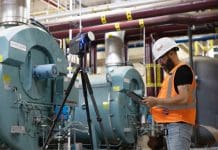Mike Smith, director, Large Enterprise and Public Sector, Virgin Media O2, explores how the applications of new technology, such as drones, 5G and BIM, are transforming the construction industry
We all know that the construction industry is having to adapt to new and unfamiliar ways of working. It isn’t alone in that respect, but it has faced unique challenges. While most office employees can work from home, buildings can’t be built from a bedroom.
Of course, with most sites remaining open during the second and third national lockdowns, the sector wasn’t the hardest hit by restrictions. However, the first lockdown, which did see site closures, resulted in a heavy backlog of projects to work through. Coupled with new health and safety measures this has meant that senior construction professionals are having to show inventiveness when it comes to approaching new projects.
What’s less widely reported is the sector’s uptake of digital technology to help construction projects run smarter at a time when the way we all work is changing. Digital platforms like BIM (Building Information Modelling) and innovations such as drones are providing support across multiple workstreams and facilitating remote access to sites. Both allow projects to continue at a time when they might otherwise have ground to a halt.
While construction has been slower than other sectors to embrace digital adoption in the past, decision-makers made impressive progress during the pandemic. In fact, our recent research with the Centre for Economics and Business Research (CEBR) found that Covid-19 has accelerated digital transformation in the construction industry by nearly three years.
Here are just some of the ways building projects are using digital tech to give traditional ways of working a 21st-century makeover:
Collaborative work has never been simpler
In the last two years, we’ve seen remote and hybrid working become the new normal across the UK. While construction still relies heavily on on-site workers, the ability to connect and collaborate with other stakeholders involved in the project who are operating remotely is crucial.
Once a difficult obstacle for the industry to overcome, digital transformation has now unlocked new possibilities. Remote monitoring tools coupled with high-speed connectivity mean that any member of a project can communicate with those on site and check in on progress, regardless of location.
BIM is a great example of this: providing a virtual representation of the physical and functional characteristics of building projects. When supported by fast, flexible and agile connectivity services – across all relevant contractors – it allows companies and supply chain partners to monitor projects through a collaborative cloud platform accessible from their smartphone or tablet.
If the past two years has underlined anything, it’s the importance of connection and communication. Ensuring that companies have collaboration systems to facilitate this will be important even as lockdown restrictions are lifted. But collaboration technology is just one of several investment priorities for the sector.
Walking around a site without ever leaving the office
Emerging technologies will continue to reshape the industry. For example, innovations in augmented and virtual reality, radar and drones are fast becoming mainstays in construction projects.
Construction leaders are embracing these changes with encouraging enthusiasm. 76% said they were likely to invest in at least one digital innovation before the end of 2021, according to Deloitte.
When applied correctly, investment in these new technologies can transform traditional processes. Take Northumbrian Water Group as an example. As a company, Northumbrian Water needs a range of technical skills and competencies to manage the logistical challenge of maintaining water and sewerage services across the North East. 5G-enabled augmented reality (AR) technology can allow experienced technicians to remotely guide on-the-ground teams through complex tasks by relaying real-time data and instructions, creating ‘Remote Experts’. The technology also allows multiple experts to join one call simultaneously, adding valuable second opinions.
Building digital solutions will ensure that businesses are ready to embrace AR, VR, drones and many more IoT (Internet of Things) technologies that will bring efficiency and ease to projects.
Digital monitoring to improve user experience
The benefits of digital services go beyond construction workers and right through to end-users. Occupants and residents now expect seamless connectivity as a necessity, so construction project leaders must put this first when developing a new home, building or place of work.
Canary Wharf Group (CWG) has successfully integrated seamless connectivity into its estates. Every building is fully serviced with 5G and ultra-fast Wi-Fi, providing users with the connectivity they need – be that in an office, an apartment, or even as they walk through the area’s green spaces.
With more than 100,000 people working and living in Canary Wharf’s 16 million square feet of buildings, digital transformation – and the impact on people – must be a central consideration.
Creating digital-first spaces can improve experiences in other ways, too. CWG monitors the air quality and cleanliness of its buildings, gathering precise, real-time data to help improve energy efficiency and ensure communal spaces are kept up to standard.
By investing in connectivity solutions, more companies can develop buildings and environments that meet the needs of people and businesses – creating a better quality of life for those who use them.
New opportunities for the construction sector
From what was initially a period of serious decline, construction has bounced back. Embracing new technologies that support developers has helped create exciting new opportunities and these have, in part, contributed to annual construction output price growth being at its highest rate since records began in 2014.
This year, investment in construction technologies and connectivity will continue to facilitate improved collaboration, innovation and allow the sector to advance with much improved efficiency and execution. It’s something that COMIT (Construction, Operation & Maintenance through Innovative Technology) – an organisation we’re a member of – has been focused on since 2003. It’s all about combining knowledge (people), process and technology to improve productivity. Connectivity like 5G is set to play a major role. In fact, COMIT predicts that technology could help reduce capital projects costs by circa 30%, with a concurrent reduction in cycle times.
This year, investment in construction technologies and connectivity will continue to facilitate improved collaboration, innovation and allow the sector to advance with much improved efficiency and execution.
To help achieve this, construction leaders must act to keep up the momentum. Now is not the time to rest and reflect. Instead, they should focus on continuing investment and innovation, ensuring the industry is ready for future success and helping grasp a £236bn opportunity for the UK economy.













